3D printing is an invaluable tool for prototyping designs and manufacturing end-use parts. However, a 3D printer is much more than just a tool. It can also be thought of as a toy (to be carefully played with). A toy for making other toys! Using 3D printing to make toys gives you control over the material, color, size, and other details, so the resulting prints will be unique!
If you don’t have a 3D printer, you can still create some amazing 3D printed toys with Craftcloud. With suppliers around the world printing to your specifications, the kids (or adults) in your life will be delighted while someone else does all the work!
With thousands and thousands of 3D printable toy designs, it’s difficult to choose just a few. With that in mind, here are some super fun toys that fit into three main categories: Print & Play, Some Assembly Required, and Batteries Not Included.
Now, let’s stop playing around and get to the list!
Print & Play
These models can be printed and ready in one go! Here are some toys that will get the fun rolling in no time.
Catapult
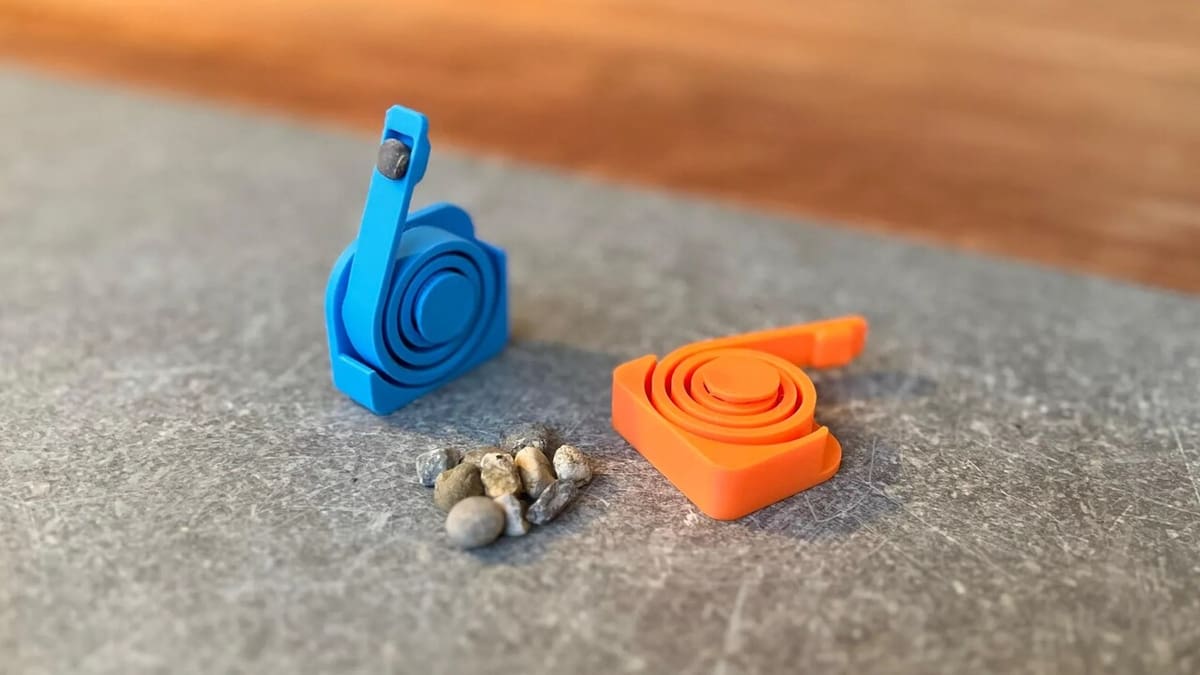
Here’s something you can do with that leftover filament at the end of your spool to make something really cool. With just 13 g of filament, you’ll have a powerful yet tiny catapult capable of launching projectiles up to 10 meters away! You can shoot all sorts of small objects, but the majority of suggestions for ammunition on MakerWorld are “printer poop“, and it’s easy to see why. Not only does the small amount of colorful filament have nice flight possibilities, it’s also unlikely to hurt anyone.
The designer’s shared a printing profile that includes a layer height of 0.2 mm and 15% infill, while they also recommend enabling supports, with the “Support only on printing plate” setting.
In just 20 minutes, you’ll have your siege weapon ready for battle.
It may seem like a stretch to imagine that something so small can shoot far, but several users, like pbgran and Terbo confirmed that they were surprised by its power. Print it and get ready for some colorful action!
- Who designed it? sdaendi
- How printable/popular is it? An incredible 2,700 prints and 3,700 downloads of this print-in-place model show that the battle is just beginning.
- Where to find it? MakerWorld
Flexi Sea Creatures
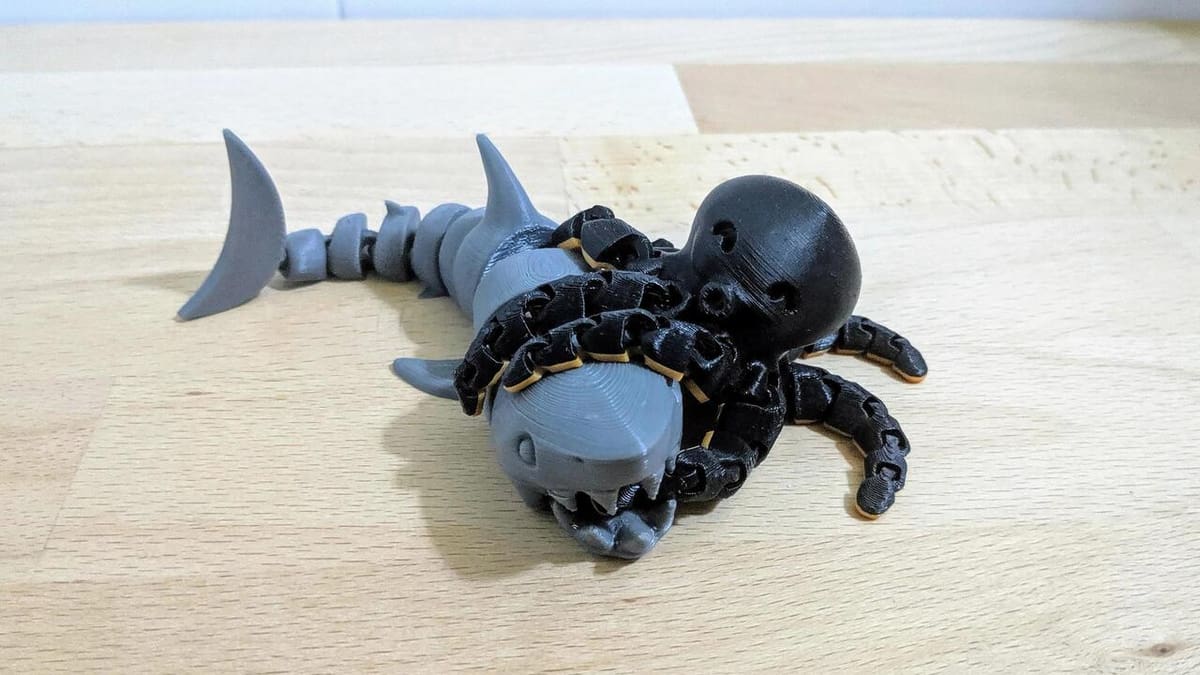
With a wide variety of filaments available, flexible parts are absolutely feasible. But you don’t have to use TPE or TPU to create flexible parts.
Making use of some awesome print-in-place hinges, you can make flexible toys with filaments such as PLA, PETG, and ABS. You don’t even need special settings! A standard 0.2 mm layer height and at least 15% infill will work just fine.
The shark and octopus we’ve included here are always popular examples, but there are countless flexi animals on platforms such as Thingiverse.
- Who designed them? McGybeer
- How printable/popular are they? The shark has around 350 makes on Thingiverse, with glow-in-the-dark filament prints looking especially cool. And the adorable flexi octopus has 1,000 makes and counting!
- Where to find them?
- Shark: Thingiverse
- Octopus: Thingiverse
Chunky Trucks Collection
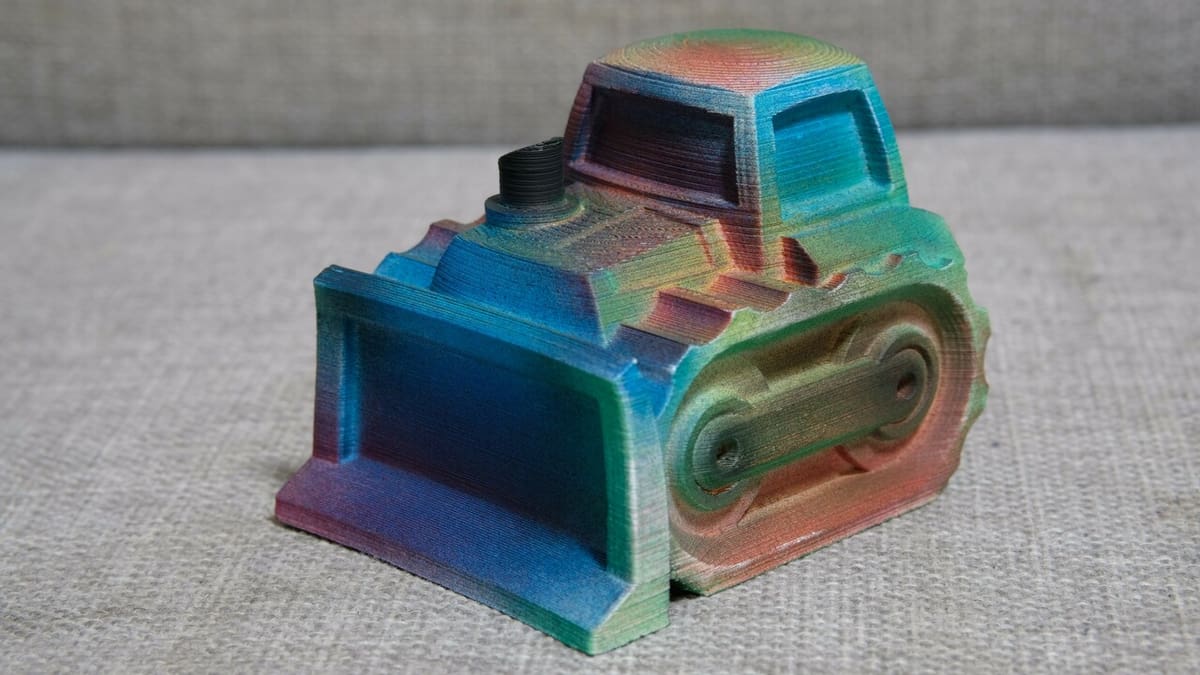
Titan Transporter, Power Pusher, and Mighty Mixer are just 3 of the 13 adorable designs in the Chunky Truck Collection, which includes various construction worker designs and even a crossing guard. The trucks are chunky enough for babies to play with. However, you might want to keep the construction worker toys away from kids who might put them straight into their mouths!
All of the designs are printable without supports. Consider printing with at least 25% infill and three perimeters to increase the longevity of the toys.
- Who designed it? MakerBot
- How printable/popular is it? Each design has several makes proving their printability. Prints with paint jobs are particularly impressive, though solid color prints are probably just as fun. You can even print multi-material remixes by cipis.
- Where to find it? Thingiverse
Minecraft Steve's Scooter
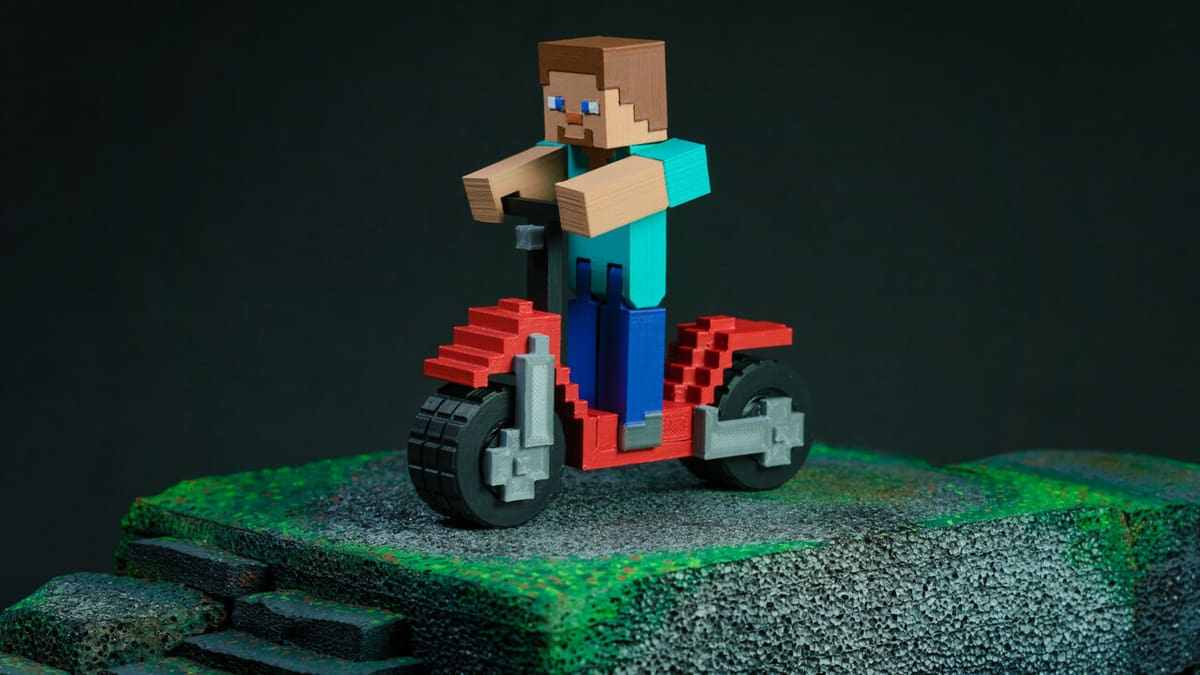
Minecraft Steve is the best Steve. Do you know any other Steve who is also print-in-place? Doesn’t matter, even if you do, this one comes with their own scooter – which is also print-in-place. Take that, other Steves.
Of course, this is a great gift for any Minecraft kid, but you’ll have to paint it before gifting it. Or, and this is totally not a cop-out, make it a weekend project with them. Seriously though, if your kid has the skills, painting it should be loads of fun.
Tetris Balance
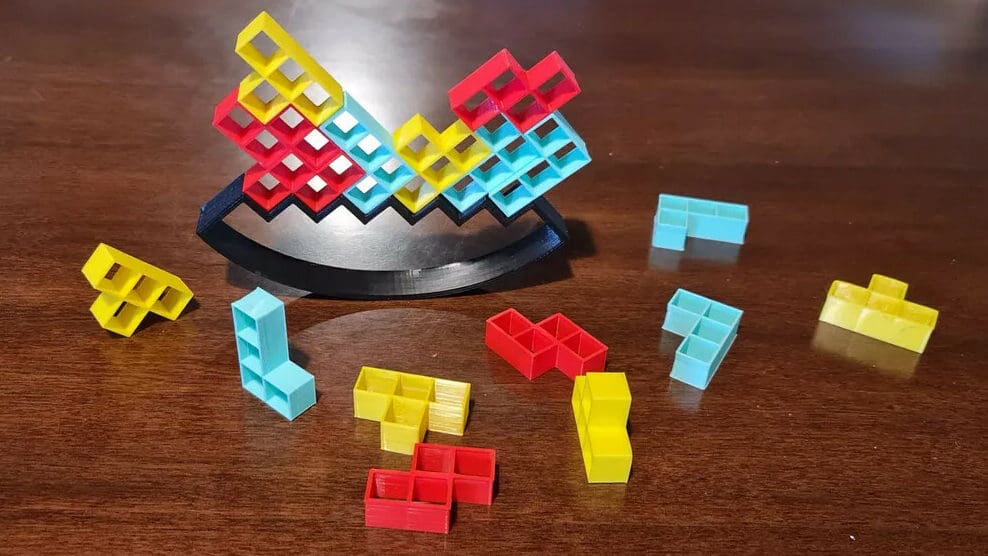
Just like the original, this game is simple and yet so much fun! Players take turns placing Tetris pieces, trying not to make the whole thing collapse. You can even choose the difficulty by using taller or shorter bases.
It’s another”end-of-spool” models where you can use leftover filament. If you’re looking for a box or some alternative pieces, check out the remixes.
- Who designed it? Bhorian
- How printable/popular is it? It’s easy to print, as is evidenced by the almost 140 colorful makes posted on Printables.
- Where to find it? Printables
Bird Whistle
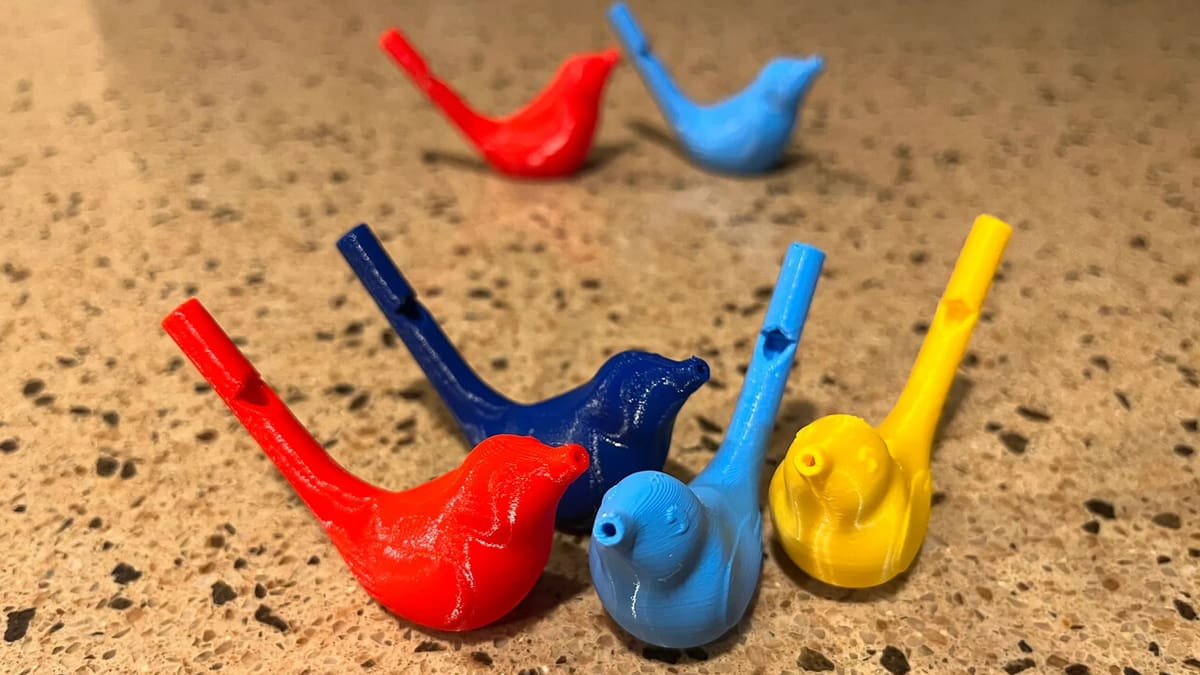
This bird-shaped whistle chirps like a real bird when you put some water in it. Younger kids love these, and we have to admit we’re a little partial to them ourselves. They’re just fun! Outdoor fun, of course, because dripping is guaranteed.
Our standard PETG recommendation for projects involving water applies here, but plenty of makers out there confirm that PLA works fine. If you want to make it as watertight as possible, we have a few pointers that might help.
- Who designed it? Sevro
- How printable/popular is it? Most of the 103 makers don’t just print one. For example, user AndyLowe printed 50 for kindergarteners.
- Where to find it? Printables
Singing Frog
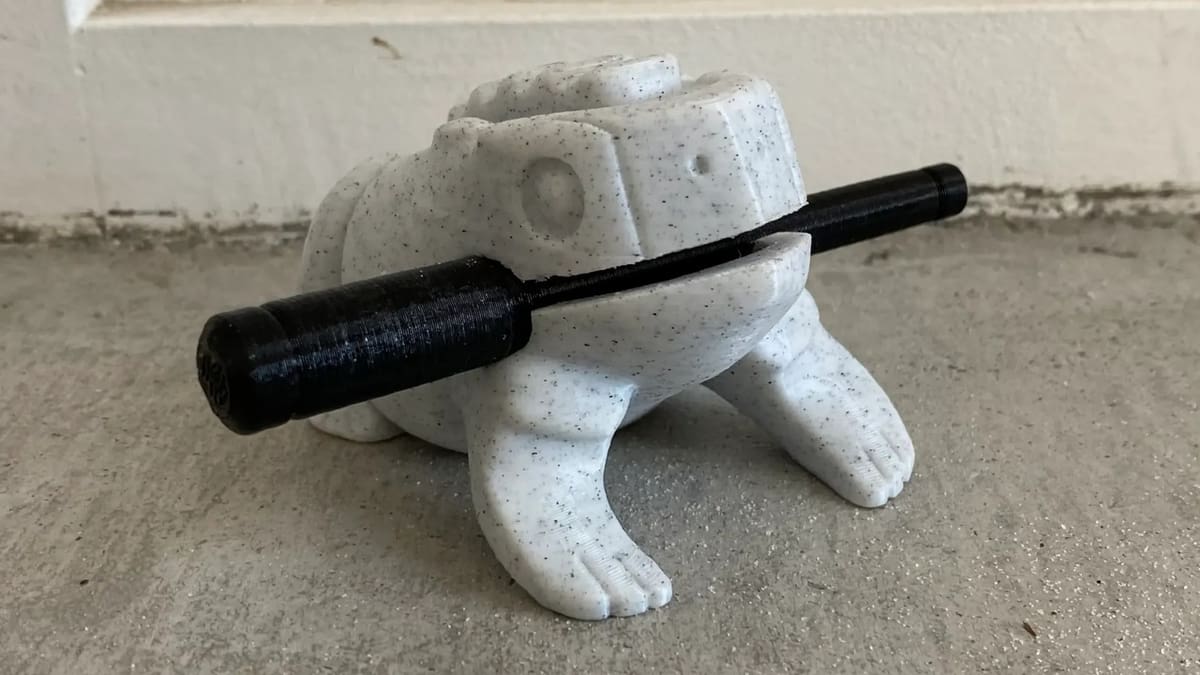
You may have seen these percussion frogs before. Rolling the included stick along the back of the frog produces a very realistic recreation of a frog ribbiting. Normally, these frogs are made out of wood. Luckily, they sound just as good when they’re 3D printed.
To get the right sound out of your frog, you’ll need to use a high infill percentage for the vibrations to align just right. Scaling the frog will make it produce a higher or lower pitch, so play around with the size until you find a pitch that you like.
- Who designed it? Wheelbarrow_of_melons
- How printable/popular is it? You can find over 230 makes of this precious little guy on Printables alone!
- Where to find it? Printables, Thingiverse
Garbage Truck
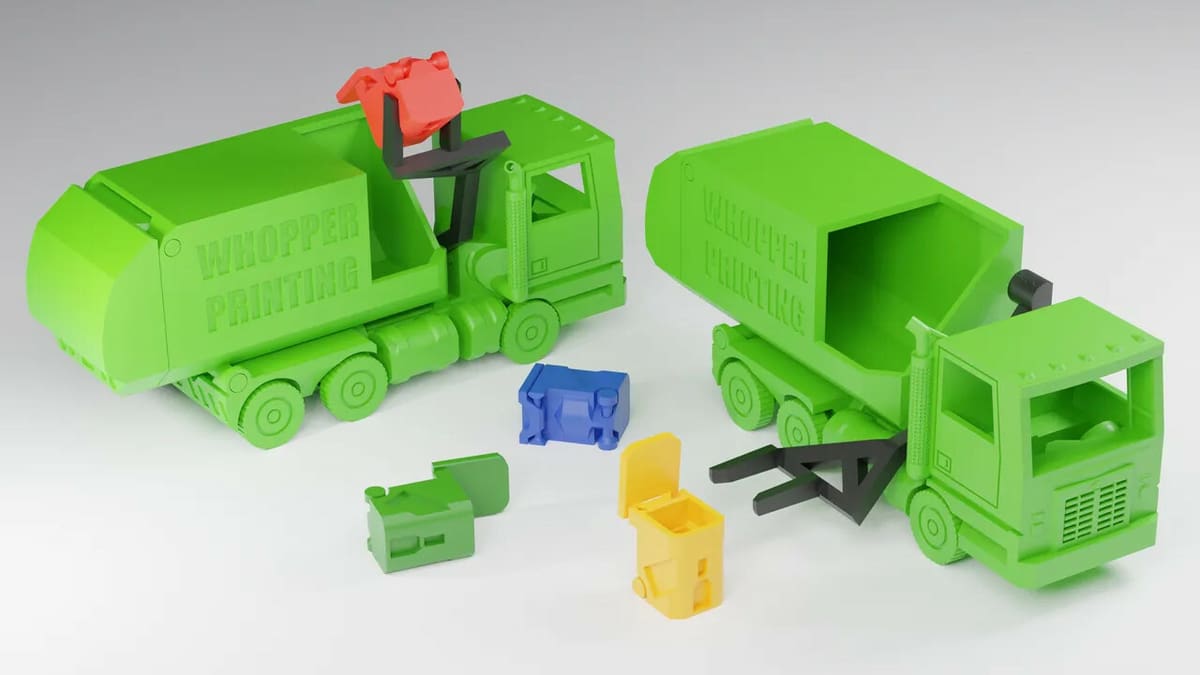
This print offers plenty of fun! It includes moving wheels, working levers for picking up trash, and a trash can (or more!) with a working lid and wheels. Everything is cleverly designed to just print in place and play.
Plenty of makers posted comments noting how much their kids love playing with the truck. If you like this one, you might want to check out some other print-in-place designs by WhopperPrinting.
- Who designed it? WhopperPrinting
- How printable/popular is it? There are around 170 fun makes on Printables, where it won the “Toy Cars” contest.
- Where to find it? Printables
Collapsing Swords
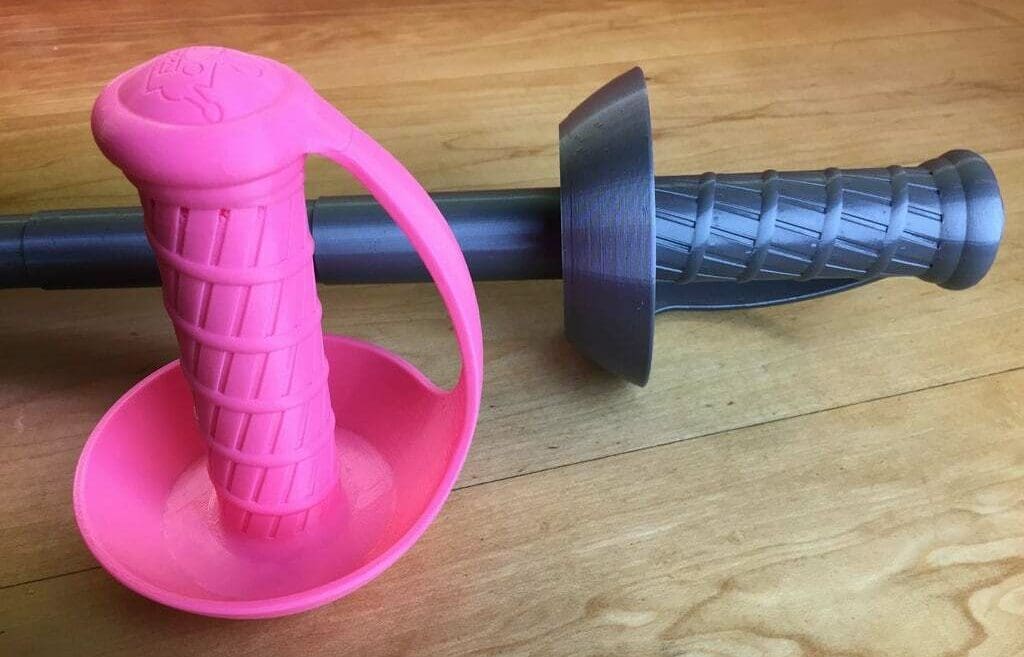
This may probably not be the best thing to hand your kid to keep them occupied in an antiques shop. In the right environment, however, collapsible swords are loads of fun. The designer has created collapsing pirate swords, katanas, daggers, lightsabers, and more to add even more fun to make-believe games.
A successful print of a collapsing sword requires a printer with good retraction, wipe, and coasting settings. Be sure to use a 0.4-mm nozzle and print slowly to avoid letting the blade sections fuse together. After you pop the sword off your build plate, give it a few wiggles, and gently retract and collapse the blade to allow for a smoother collapse over time.
- Who designed it? 3DPrintingWorld
- How printable/popular is it? 171 makes have been posted in a variety of colors, materials, and printers. Just be sure to dial in your retraction settings and consider using a forgiving material like PLA instead of PETG.
- Where to find it? Printables
Warhammer Bolt Gun
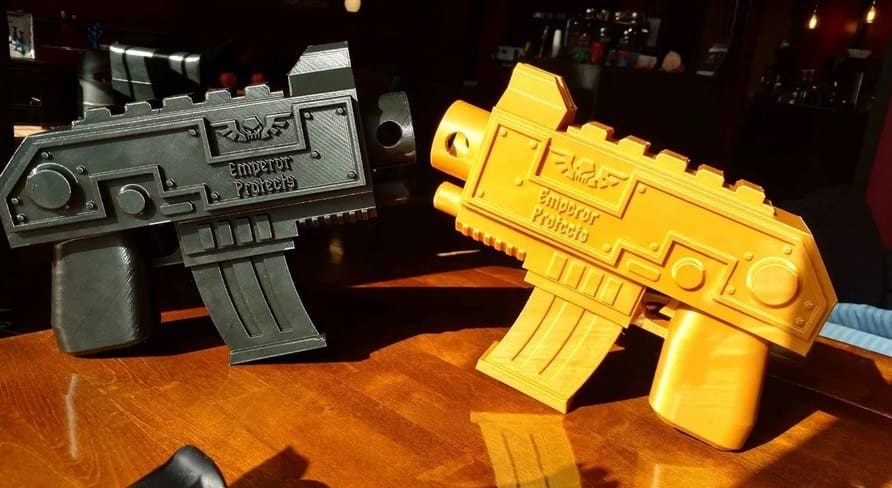
This bolt gun should be familiar to you if you’ve ever played Warhammer 40,000. Now, you can physically create one of these weapons! Opting for a printer with a small build plate is only possible if you scale down the model since it’s rather bulky – around 500 grams of PLA filament will be consumed.
One of the members who has printed this model commented about its wide handle and suggested slimming the 3D model for easier handling.
- Who designed it? lancegreene
- How printable/popular is it? The entire gun can be printed as a single piece. It has been downloaded over 1,300 times with 13 makes shared.
- Where to find it? Printables
Some Assembly Required
These toys may require some parts to be collected and put together.
Twisted Spinning
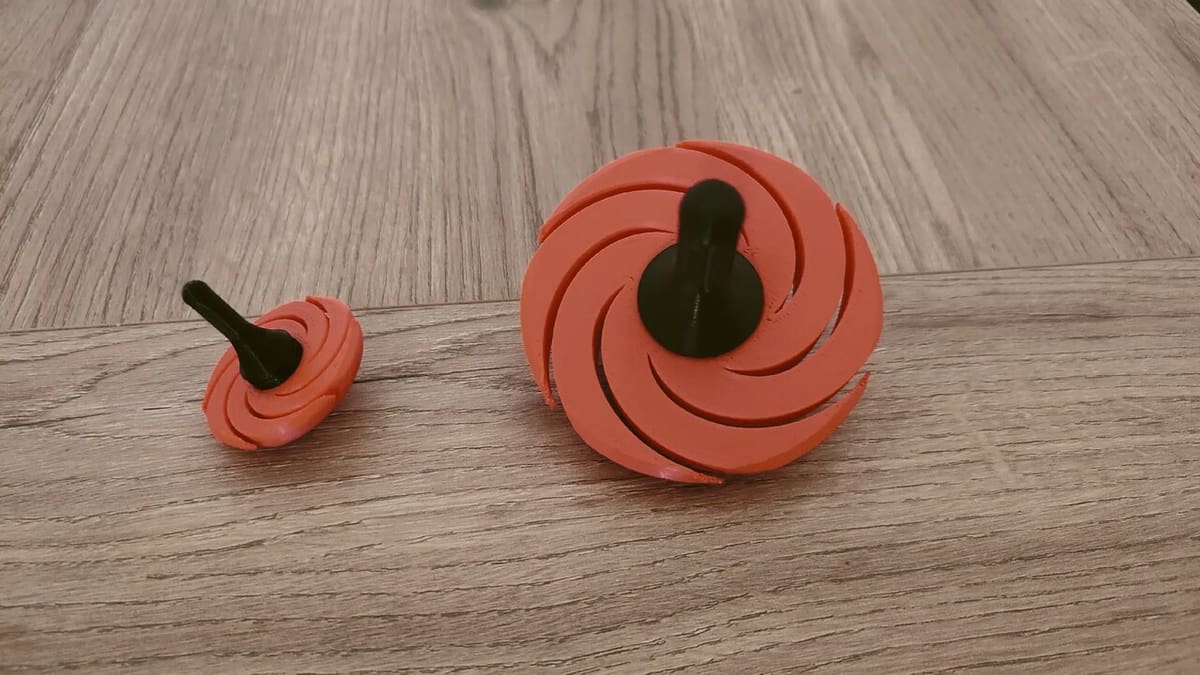
Spinning tops are said to be the oldest toys in the world, dating back nearly 6,000 years. Ancient spinning tops were made from everything from stone and wood to fruits and nuts. And now, you can make your own spinning top with a 3D printer! All you need to do is print and assemble the parts for some dizzyingly fun.
To replicate this, the author recommends using PLA with 100% infill, a layer height of 0.2 mm, and two walls. Other important tips are to configure the slicer to print the outer perimeters first and to orient the body part of the pawn towards the opening of the print bed. Several makers, such as Kristina 3D Prints, have praised the ease of printing and assembly. Because the pin on this model is held in place with a screw thread, it eliminates the need for glue – you’ll be ready to spin in no time!
- Who designed it? prntmkr
- How printable/popular is it? With over 4,800 downloads and 75 makes, it’s no exaggeration to say it prints as well as it turns.
- Where to find it? Printables
Squishy Turtles
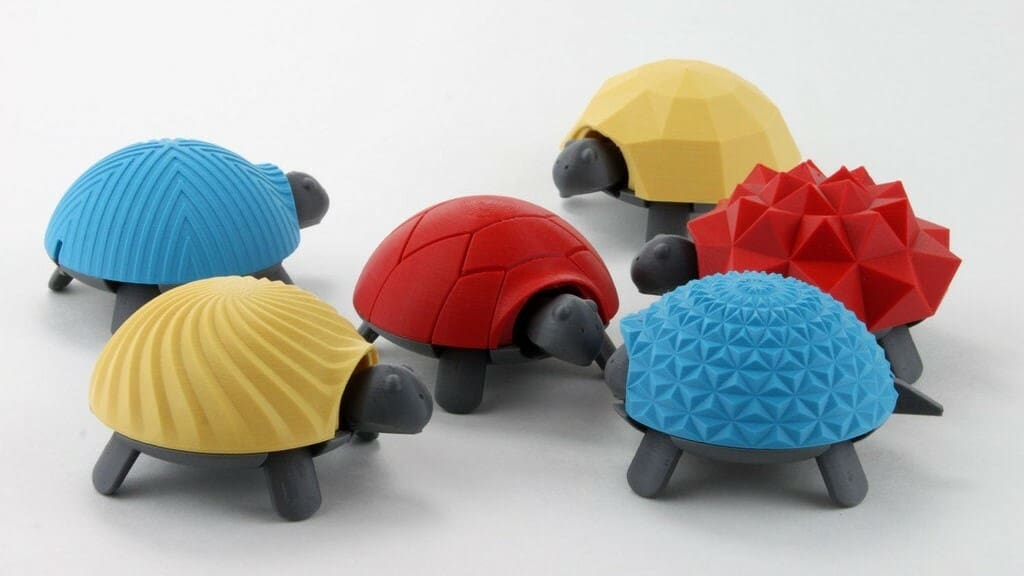
A toy list would never be complete without squishy turtles. Even the name sounds fun! With countless shell designs to choose from, this is a quick and easy model to print for babies.
Created with a suspension design, these turtles bounce up and down when you push down on the shell. Run wild with colors and designs, and be sure to check out the creator’s design process.
- Who designed it? jakejake
- How printable/popular is it? Over 730 Thingiverse users have offered pictures of their prints. The possibilities are endless for color and shell design combinations.
- Where to find it? Pinshape, Thingiverse
Mini 13
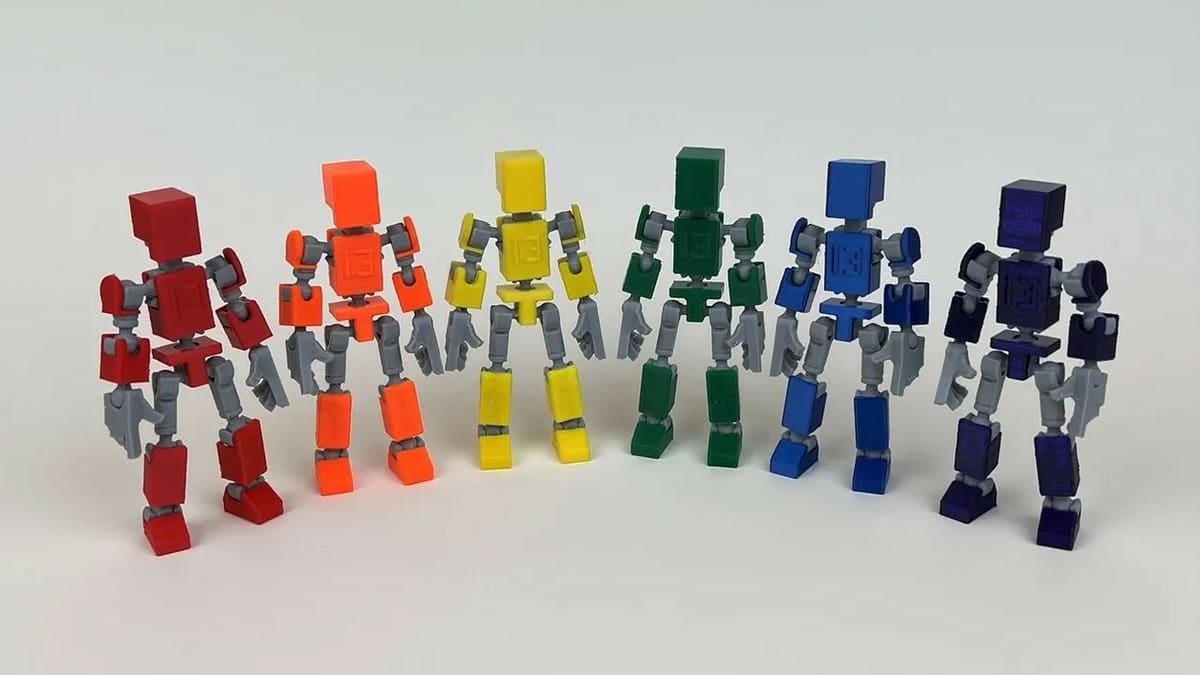
This extremely popular jointed figure is super modular and customizable. As the little sibling of the popular Lucky 13, Mini 13 is easier and faster to 3D print than the original model.
The designer recommends PETG for the frame parts, three perimeters, and a layer height of 0.15 mm. One of the main merits of this posable, snap-together print is the large community behind it. The remixes present limitless possibilities, with accessories, weapons, or even full character transformations!
- Who designed it? soozafone
- How printable/popular is it? There are over 705 posted makes on Printables, with many fun action scenes with multiple actors, props, and vehicles.
- Where to find it? Printables
Little Cities – Fire Station
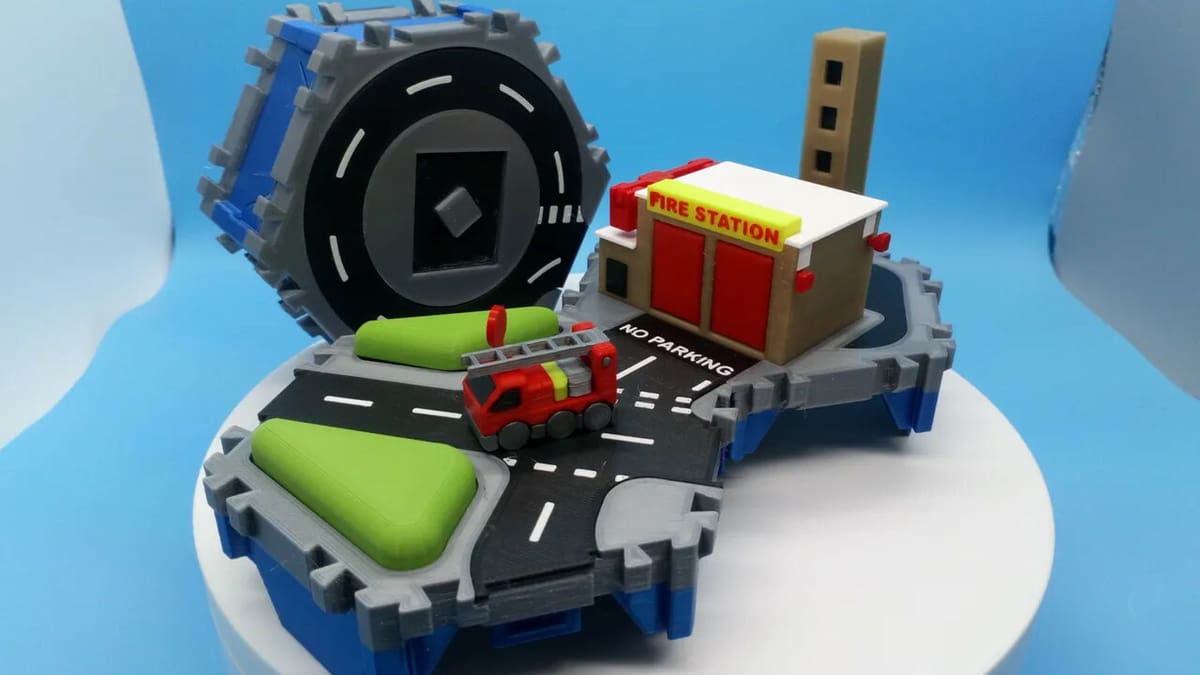
Here’s an entire play set in a box. This set includes a fire station with a button that lets out a fire engine with working wheels and a ladder. This part of the city connects to other parts in the Little Cities series, like the quarry, the hospital, and the fun fair.
This is a colorful print with some very forgiving tolerances, and no multi-material unit (MMU) is needed.
- Who designed it? neil3dprints
- How printable/popular is it? Six users printed this fire station on Printables. All of them turned out nice and colorful!
- Where to find it? Printables
Skewbits
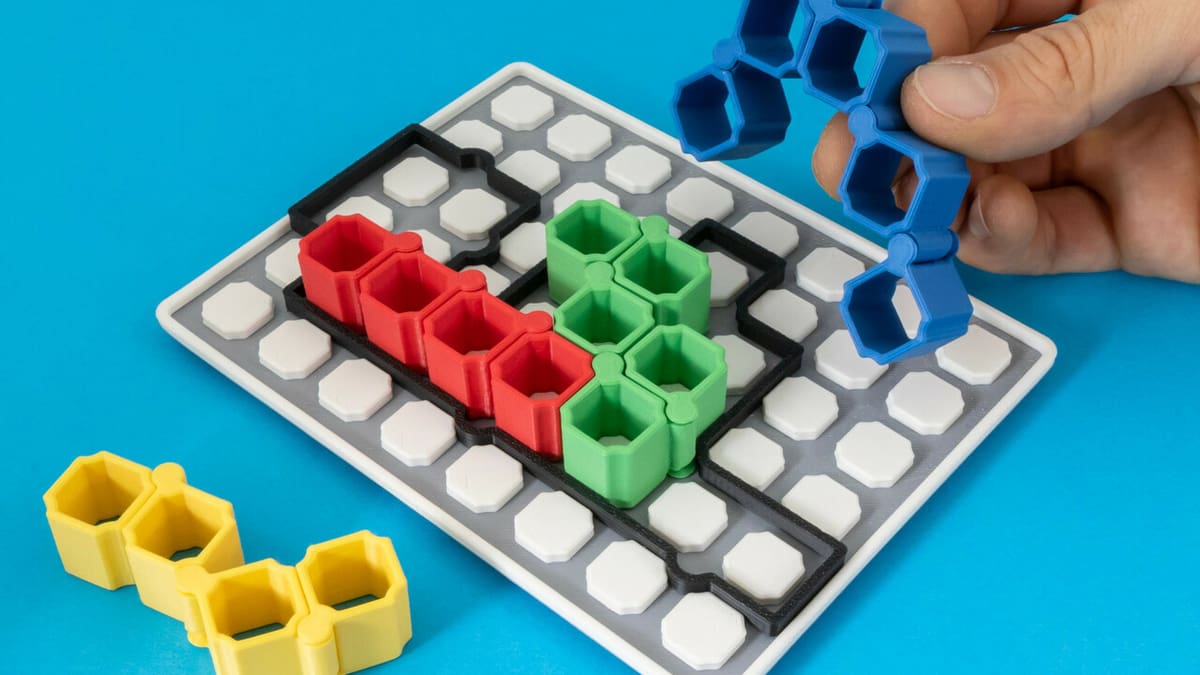
Devin Montes at Make Anything came up with a pretty cool new puzzle game while trying to solve a totally different problem. Not discarding our mistakes can actually lead to great things, and here’s a video that proves it.
The game, Skewbits, is very tactile. Players morph the four base pieces into various shapes according to the preset puzzle outline. We have our money on kids spending more time in freeform creative mode, however.
The author also released version 2.0, with both aesthetic and functional improvements, including 50 problems to solve – check out the video!
- Who designed it? Make Anything
- How printable/popular is it? The game already has nearly 2,300 downloads, and a handful of makes have been shared.
- Where to find it? Thangs
Surprise Eggs
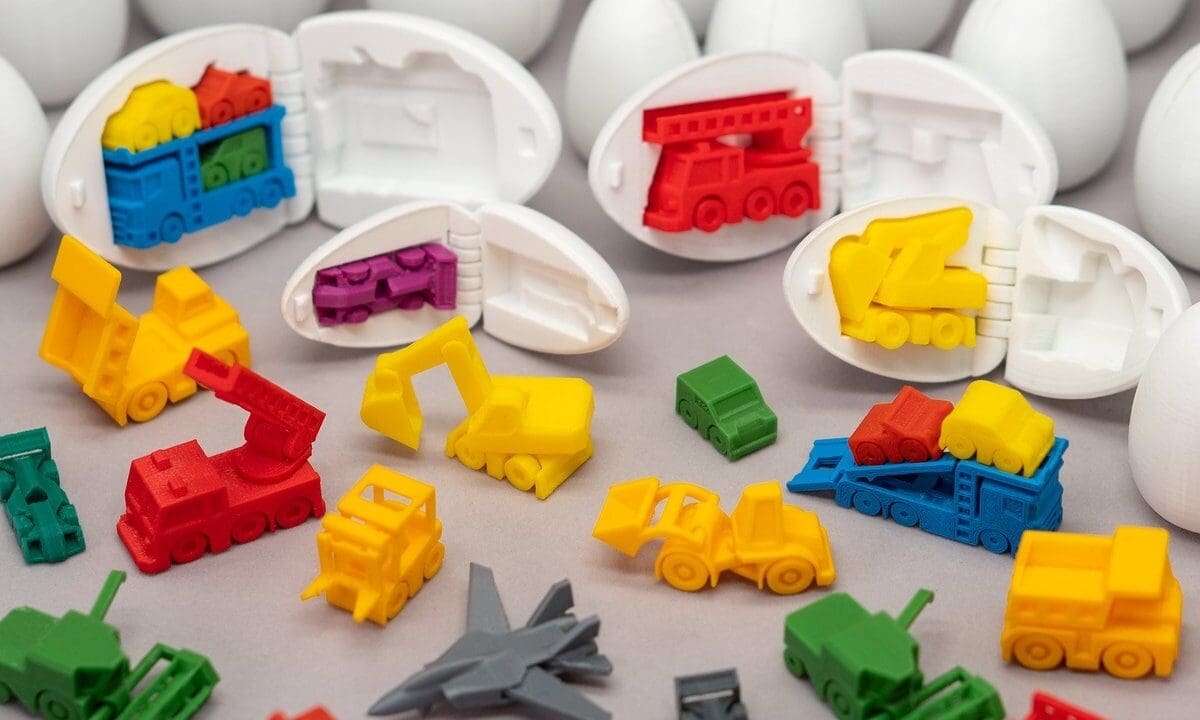
Bigger isn’t always better. In fact, sometimes the most fun comes in small packages, and these 3D printed surprise eggs are no exception.
These tiny vehicles with moving wheels and other accessories are so adorably fun, and there are lots of options to choose from, too! You can print surprise eggs filled with everything from a steam roller to a fighter jet to a fire truck.
No supports are required for these models. Remember to use at least 40% infill to make sure that the small features are nice and sturdy. Since these prints have such tiny details, they double as torture tests for your printer. With a well-calibrated machine, everything should be smooth sailing.
- Who designed it? agepbiz
- How printable/popular is it? With dozens of makes for each of the 13 models, this is a very popular collection. Some makers have even had extra fun with these by scaling them up as high as 300%.
- Where to find it? Thingiverse
Puzzle Plane
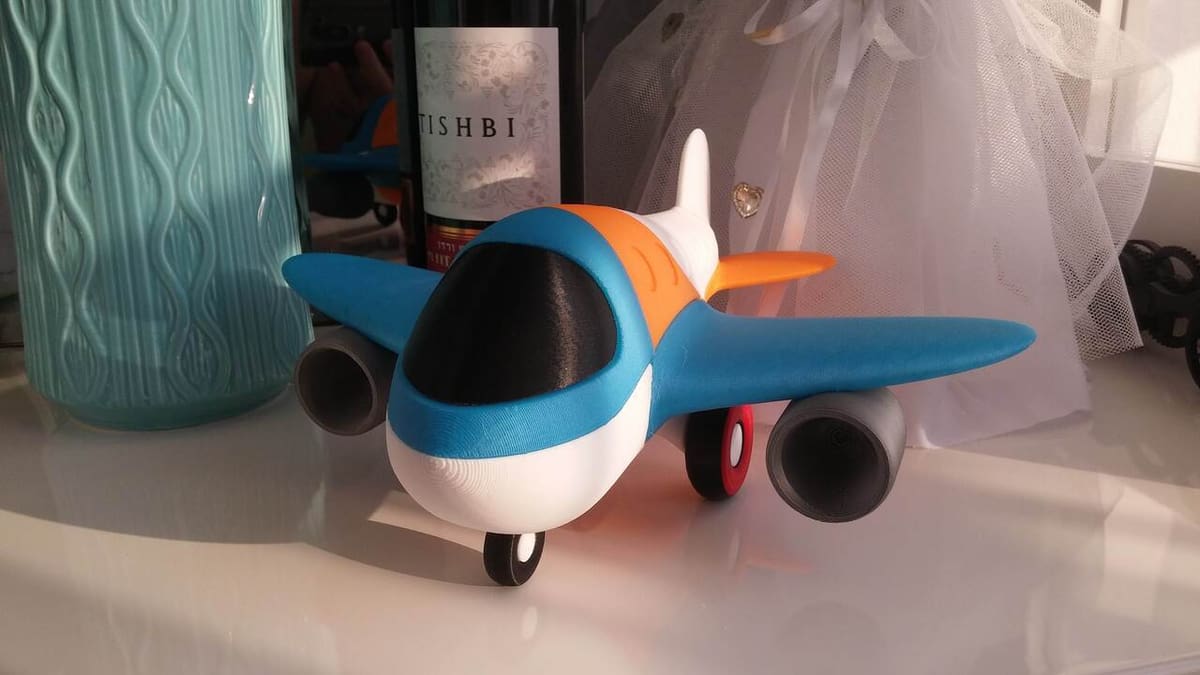
If you’re looking for something that’s both challenging and fun, this magnetic puzzle plane is a great choice. Once assembled, it will measure approximately 217 mm x 255 mm x 116 mm and, although it won’t fly, it can easily bring joy to little ones.
That said, the original model isn’t recommended for children between 0 and 3 years old due to the possibility of the 55 small magnets coming loose, as they are fixed from the outside.
Thinking about solving this, pepebuho designed a remix where the magnets are internal, but this involves a bit more work because it’s necessary to pause the printing to add a total of 109 magnets. Another remix, shared by Wildnet, offers the possibility of having rotating rear wheels.
- Who designed it? Deemoss
- How printable/popular is it? A soaring 110 makes, 7 remixes, and 148,000 downloads make it clear that it’s printable and very popular.
- Where to find it? Thingiverse
Pocket Copter
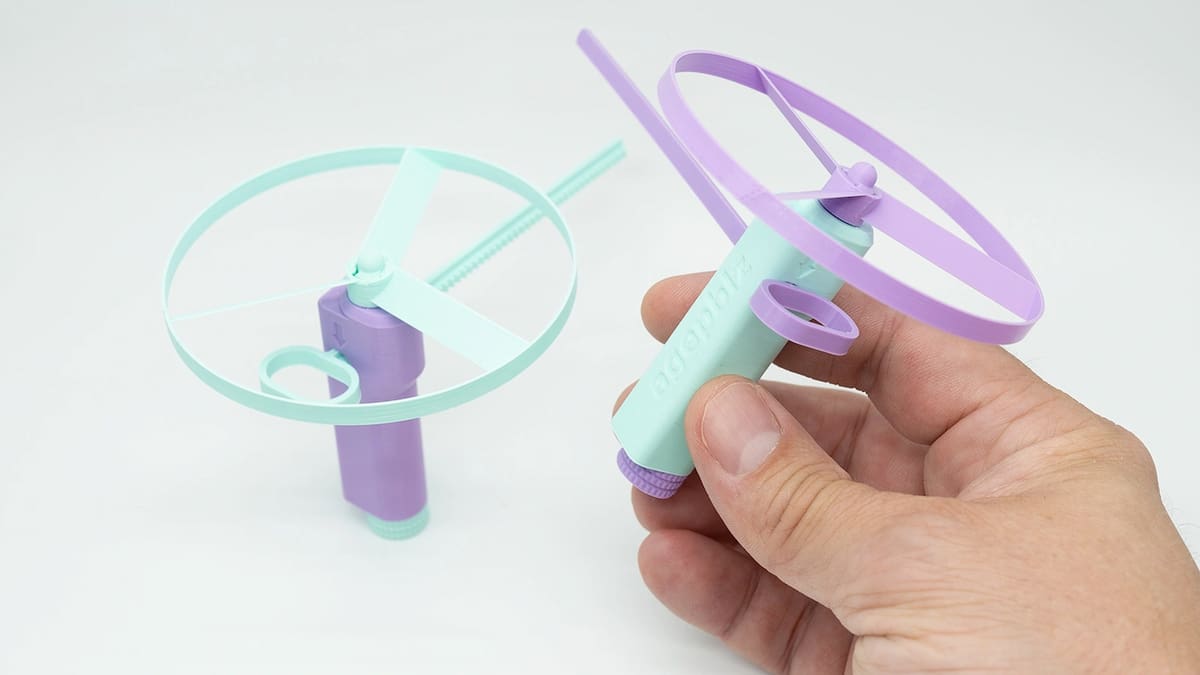
A fun and simple toy that’s sure to provide hours of entertainment to any child is the pocket copter. Using a gear and a rip cord, you can send the propeller flying into the air over and over again. Print out multiple propellers in different colors for some variety!
This toy only needs five parts to be printed, with minimal assembly required to get it up and working as soon as your prints are finished. The blades of the propeller are known to have issues printing properly, so be sure to thoroughly clean your print bed and slow down your speed if you run into any problems with printing.
- Who designed it? agepbiz
- How printable/popular is it? This is quite the popular toy, with over 10,800 prints reported by MakerWorld to date!
- Where to find it? MakerWorld
Hotrod Racer Balloon Car
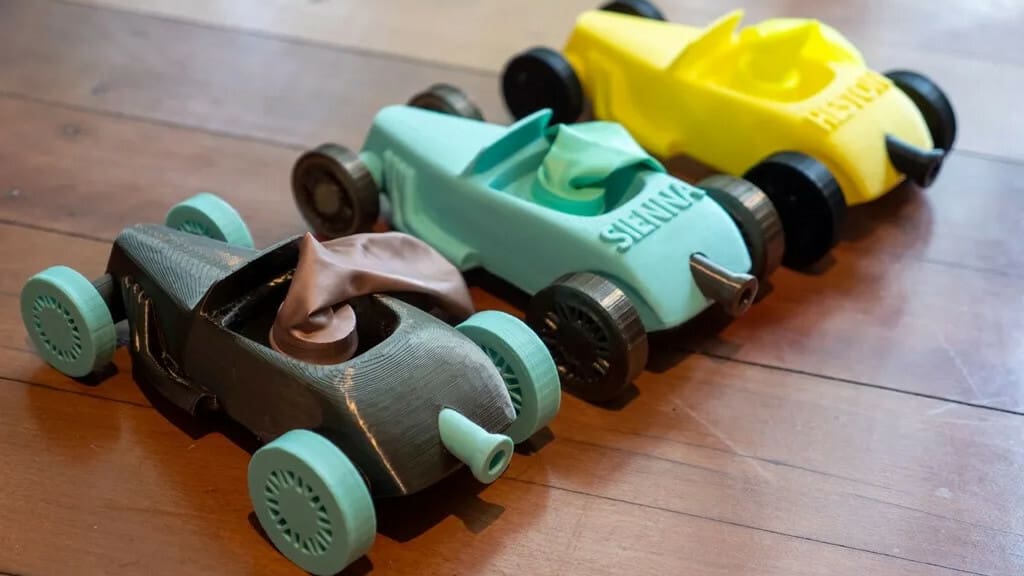
Physics and racing cars, what’s not to love? Use some colorful filament, add a couple of balloons, and the race is on!
This remix adds a mouthpiece for inflating the balloon, so you never have to disconnect from the car to re-inflate. The designer recommends using optional aluminum rod axles for maximum speed, but some users vouch for the fun they had with the fully printed version.
- Who designed it? PollyJeanius (remixed from VF)
- How printable/popular is it? There are 38 posted makes with most users posting several prints in different colors. Well, they’re called racers for a reason, right?
- Where to find it? Printables
Polypanels
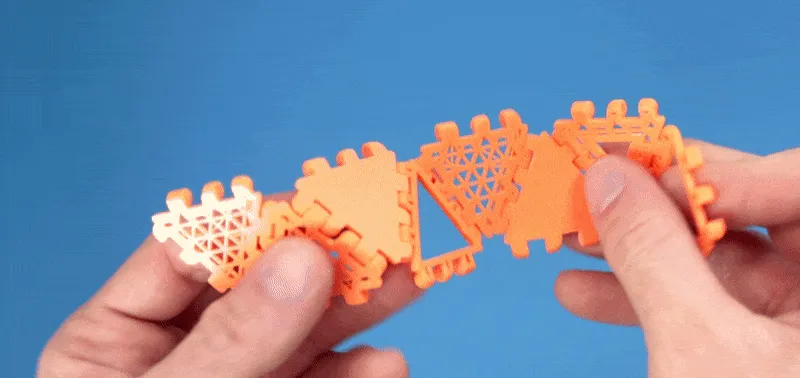
Polypanels have various shapes and sizes, but the edge connectors are always the same, allowing you to run wild with ideas. The parts snap together and can create flexible or firm shapes, so the possibilities are limitless! You can even design your own custom Polypanels.
- Who designed it? MakeAnything
- How printable/popular is it? Thousands of makers have printed and created designs with the Polypanel system. You can check out dozens of community Polypanel designs and prints on MyMiniFactory.
- Where to find it? MyMiniFactory
Beyblade
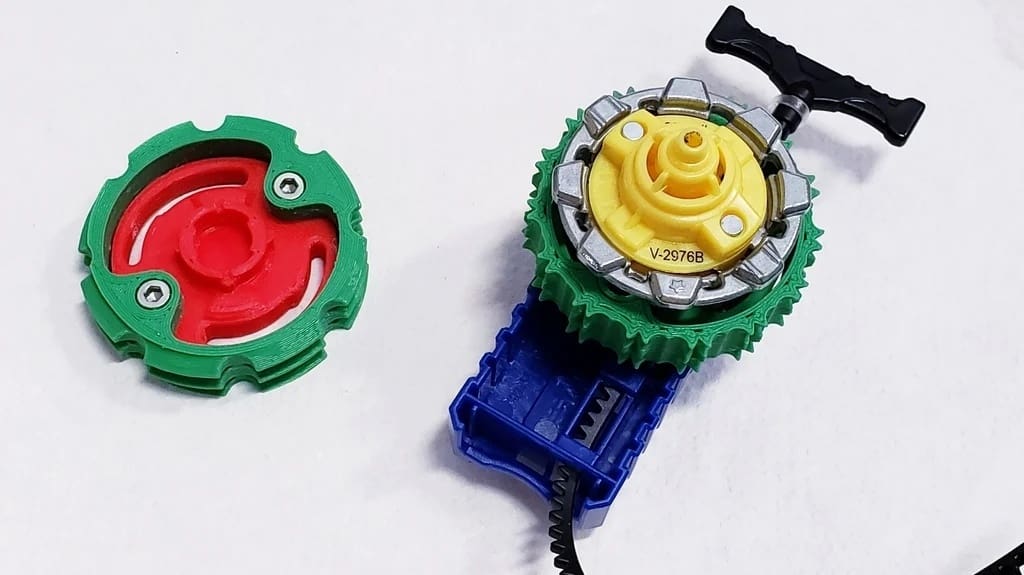
Beyblades have been around for a long time. Many makers have grown up with these toys and have seen a resurgence of their popularity among the newer generation. It’s only fitting that we can now create our own Beyblades with a 3D printer!
These models are designed for customizability, with many different parts that you can mix and match until you come up with the perfect top. You’ll need some additional hardware to complete the build, though nothing that you can’t find in your local hardware store. There’s a printable launcher file if you don’t already have one on hand.
- Who designed it? Littlefiver
- How printable/popular is it? 12 makes have been uploaded, showing just how customizable these spinning toys can be!
- Where to find it? Thingiverse
Customizable Lego
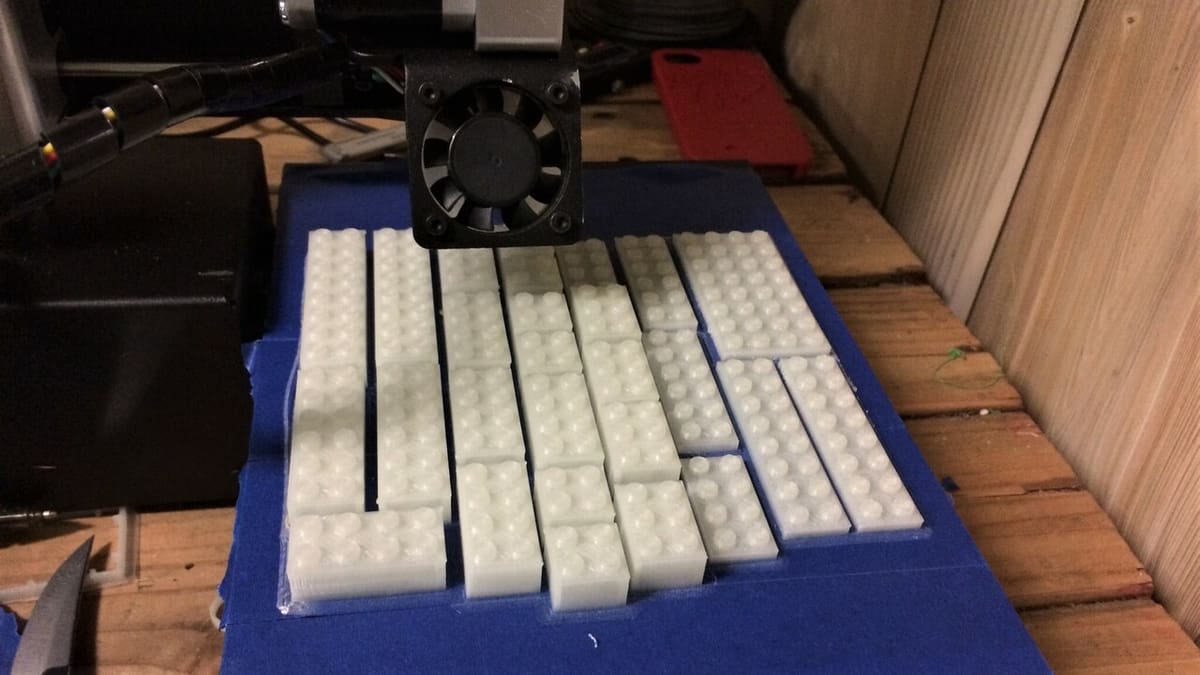
Lego bricks are among the most popular toys in the world, and the wide variety of colors, shapes, and sizes is incredible. However, with 3D printing, you can print your very own bricks customized to whatever design you are making.
Whether you need a replacement brick or a completely new kind of brick, this customizable Thingiverse model has you covered. Simply open the model in Thingiverse Customizer and go wild with the dozens of adjustable variables to create your perfect brick.
These bricks aren’t exactly identical to real Lego, but they’re compatible in every way.
- Who designed it? cfinke
- How printable/popular is it? Only 14 makes have been shared on Thingiverse. However, with over 1,000 remixes, this customizable model has gained quite some traction in the 3D printing community. Be sure to check out the remixes to find someone who’s already customized the brick you need.
- Where to find it? Thingiverse
Batteries Not Included
Building toys inspires creativity and invention. These will feature other parts that aren’t usually 3D printed, such as batteries and motors.
Skee-Ball
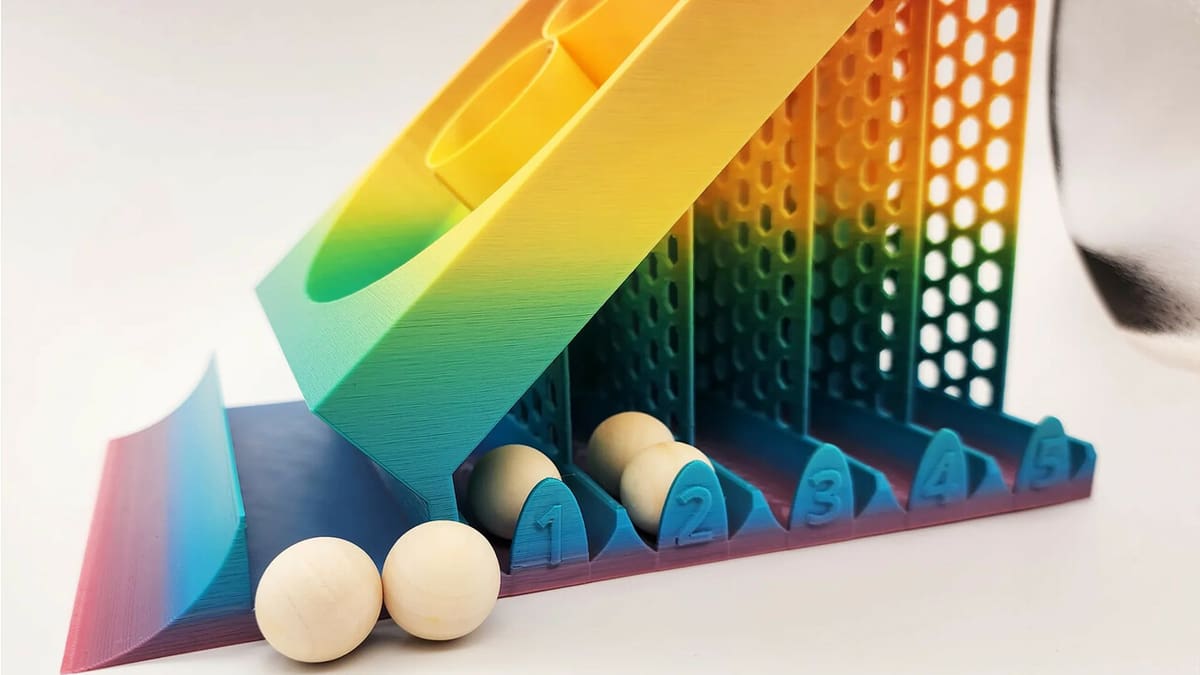
This old traveling carnival game is always a favorite with kids. They get to score some points, just not always the points they want.
As for printing, it’s an easy one-piece print with no supports necessary. Make sure to use classic perimeters, not the Arachne engine though, to avoid walls that are too thin.
You can use 20-mm balls or print some spheres from the same designer. In that case, we recommend an infill of 50% or higher, for playability. While you don’t need to buy any batteries, you can decide whether you purchase or 3D print the balls.
- Who designed it? TripleGWorkshop
- How printable/popular is it? Five makers have printed this design without a hitch.
- Where to find it? Printables
Whirligig
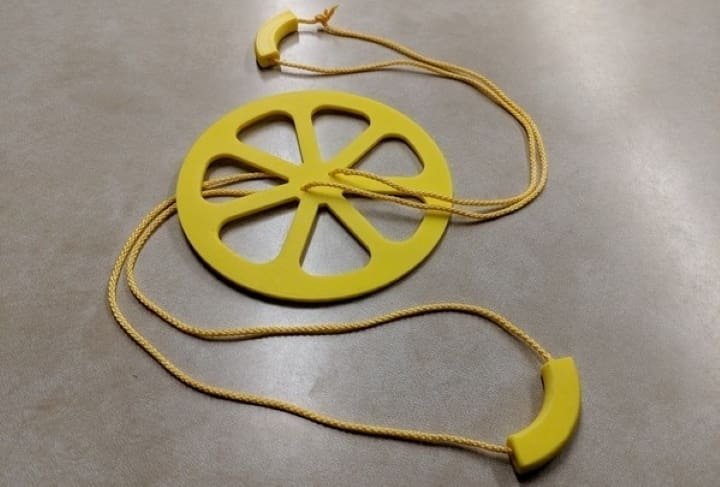
Sometimes, the best toys are those that have been around for thousands of years. This 3D printed whirligig will keep your kids entertained as they try to spin it faster and faster, just like kids did back in ancient times.
This toy isn’t hard to print, since the design is simplistic and requires no supports, but you’ll need to buy (or find some) string.
As a bonus, you can tell your children that variations of this toy have even been used to separate blood using centrifugal motion.
- Who designed it? eclsnowman
- How printable/popular is it? This spinning toy has been downloaded over 3,300 times with no issues reported.
- Where to find it? YouMagine
Magnetic Fishing
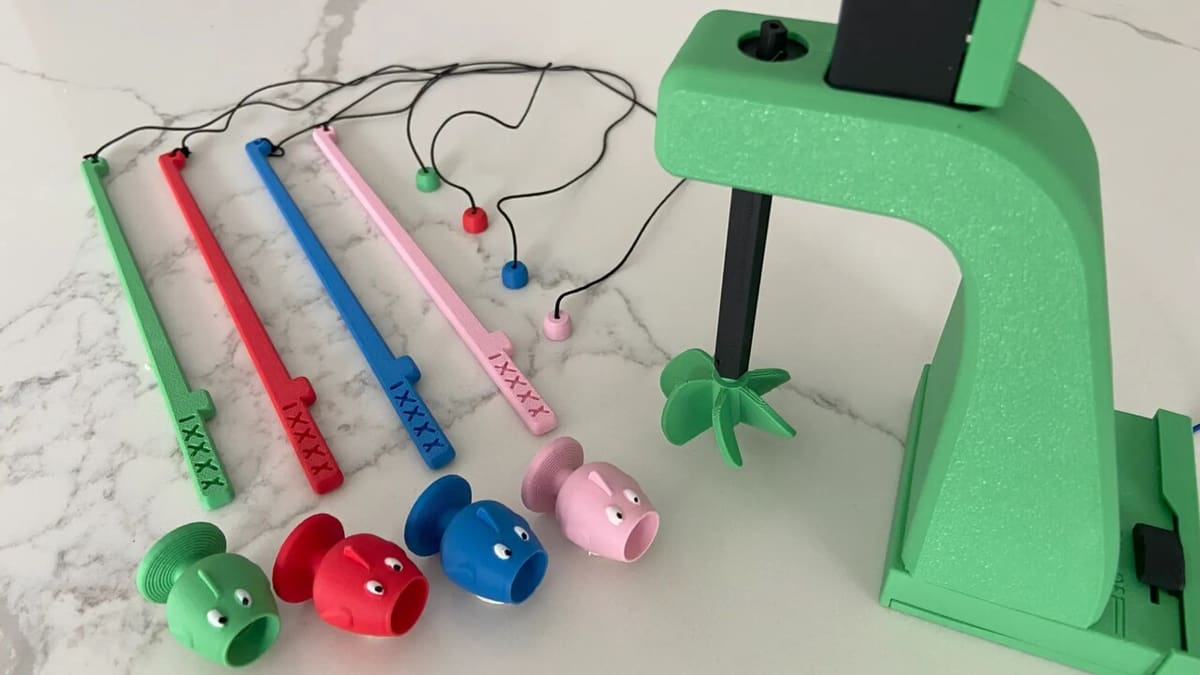
A weekend fishing trip sounds like a great idea, but what if you live in a big city far from any lakes or rivers? Well, if you have a 3D printer, the solution may be on the way with this cool toy set. The model uses Bambu Lab’s Maker’s Beginner Kit, available for ~$10, so you don’t have to worry about complicated electronics purchases. In fact, it’s mostly a matter of printing and assembling everything if you already have the magnets!
The designer included both notes and PDF assembly instructions, making the task much easier, and if you like the original version, the filament colors are specified so you can replicate it.
Printing time will depend on whether you’ve got a standard sized printer or a smaller one (e.g. Bambu Lab A1 Mini), so you might be looking at either roughly five or six hours of anticipation buildup. Settings are as 0.2-mm layer height, 2 outer walls, and 15% infill, and the ease and creativity behind this project explain why it won MakerWorld’s Maker’s Beginner Kit contest.
- Who designed it? Abe Builds
- How printable/popular is it? Over 50 makes and 420 downloads, as reported by MakerWorld, show that it won’t be difficult to make your own fishing fun.
- Where to find it? MakerWorld
Rubber Band Gliders
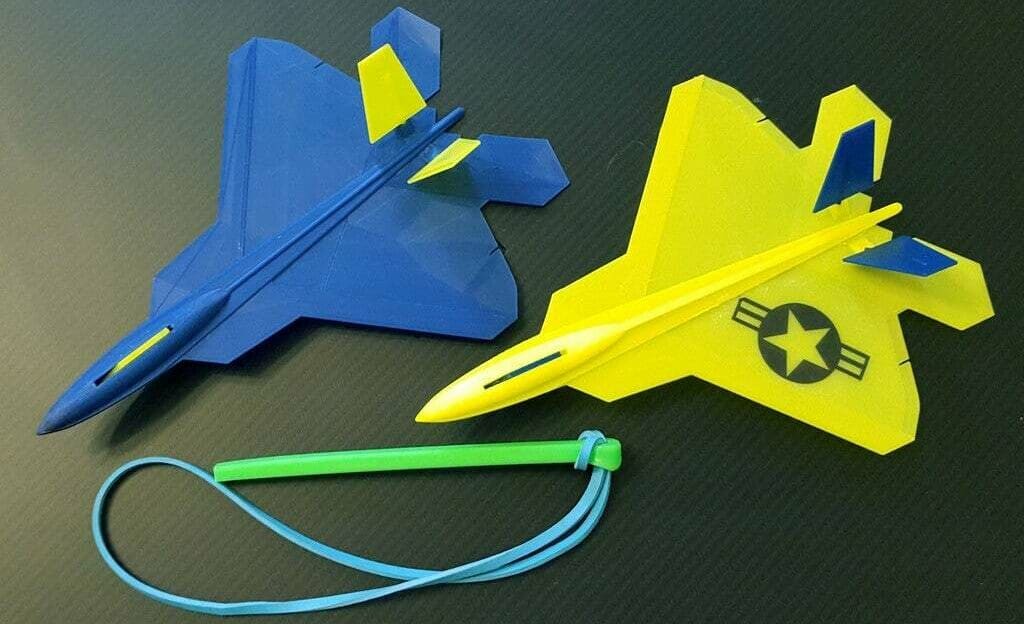
With a 3D printed glider, you can stretch even more fun out of a rubber band! Just hook, pull, and let fly! With dozens of options on Thingiverse, you can take to the skies with a whole fleet of rubber band-powered gliders.
For the model shown above, 100% infill is suggested for a sturdy glider, and remember to print at 0.1-mm layer height to allow for staggered layering that will greatly increase the longevity of the thin wings.
- Who designed it? pcgear
- How printable/popular is it? 15 Thingiverse users have posted makes of this model, and the impressive results speak for themselves!
- Where to find it? Thingiverse
Wi-Fi Propeller Boat
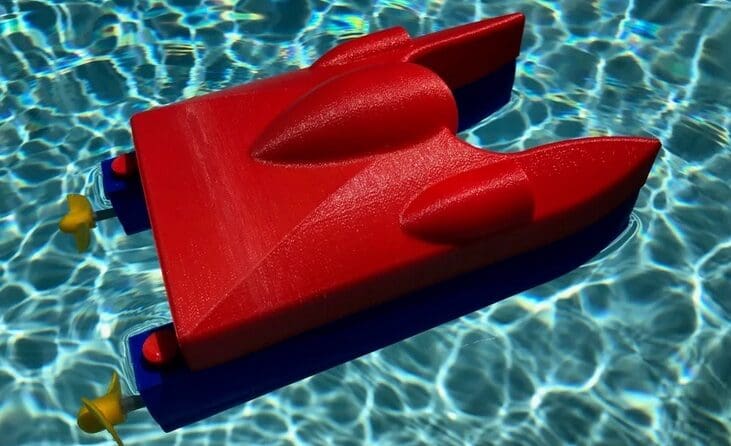
This Wi-Fi-enabled, remotely controlled boat has a complex assembly that features two propellers. It requires a Wi-Fi kit, controller, DC motors, ball bearings, batteries, resistors, connectors, and fastening tools (glue, servo tape, etc.) to connect to the 3D printed parts and operate successfully.
Although it resists splashes, it’s not waterproof and shouldn’t be submerged.
Autodesk Fusion was used to design its components. And when it comes to manufacturing, PLA filament material is recommended. You can follow the detailed instructions to set up the final assembly.
- Who designed it? gzumwalt
- How printable/popular is it? Its parts have 12 different STL files that can be edited in 3D Slash before 3D printing. They have been viewed almost 6,900 times and favorited 67 times.
- Where to find it? Instructables
T-10 Water Gun
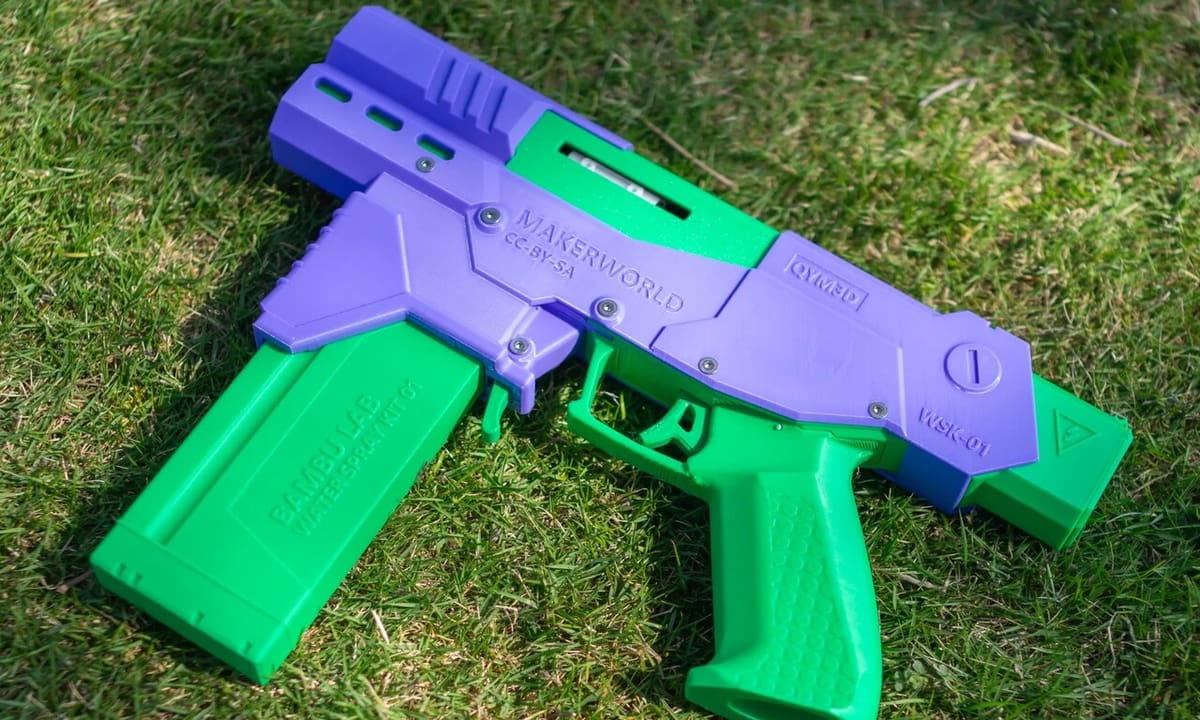
Nothing beats a water gun fight in the heat of summer, but this isn’t just a pistol, it’s a true machine gun capable of annihilating your enemy! This model makes use of Bambu Lab’s Electric Water Spray Kit 01, which costs ~$17. If you’re in doubt about its firepower, check out the assembly and testing video shared by the author.
While this water gun brings plenty of fun, you’ll benefit from paying attention to the tips shared by the designer and other makers. From using 3 walls and 30% infill to avoid leaks, to (if possible) opting for PETG or PLA+ to increase durability, there’s plenty of useful information in the comments.
- Who designed it? QYM 3D 脑洞造物秦一鸣a
- How printable/popular is it? 305 downloads, 135 prints, and counting, are bringing lots of fun to scorching summer days!
- Where to find it? MakerWorld
SLAB Nerf Blaster
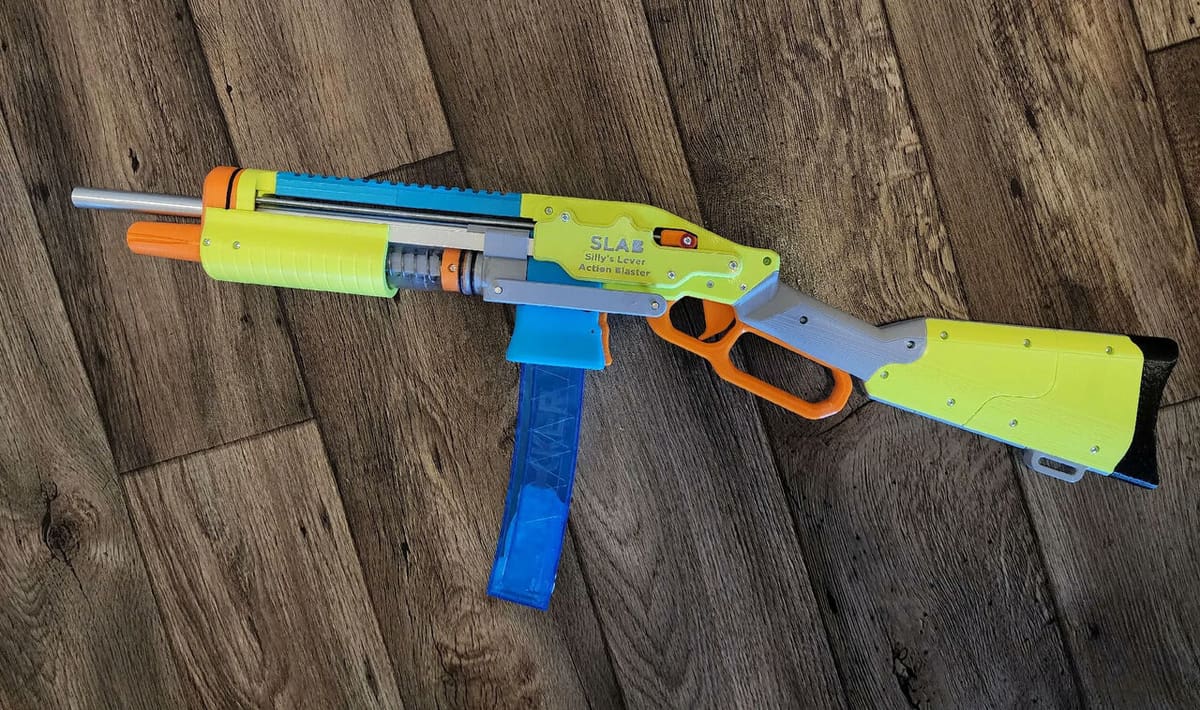
Nerf blasters and 3D printing are a match made in heaven. The amount of printable accessories that you can find for the hobby is staggering. You’ll find a good amount of fully-printed blasters as well, including the SLAB blaster. This lever-action model is one of the most popular for good reason, as it’s fun to use and easy to print.
After printing the body, you’ll need to order the rest of the hardware to complete the build. Luckily, you can find ready-to-order kits available in the model’s description, along with full tutorials for the build and tips for the best performance. The designer also has some other blaster builds uploaded as well!
- Who designed it? Sillybutts
- How printable/popular is it? You’ll find 83 makes of this blaster posted already, each in a unique color scheme.
- Where to find it? Printables
Tic Tac Gun
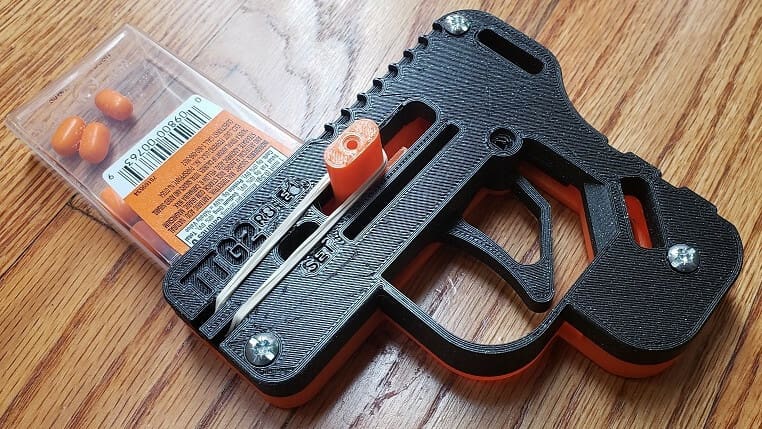
The original Tic Tac Gun is no longer available, but as you would expect, a better, easier-to-build version soon appeared. This design uses a rubber band to propel Tic Tacs at those who sorely need them.
You’ll probably want to avoid shooting them into an open mouth, though, as that presents a choking hazard. Having that said, long-range “mouth golf” is pretty fun!
For this design, you’ll need four M3 screws and nuts as well as a rubber band. Also, don’t forget to print it with non-realistic colors, as some people might not get that it’s a toy at first glance. Fun is great, but safety first!
- Who designed it? DA17
- How printable/popular is it? There are 23 confirmed makers out there serving justice and fresh breath. Wait, what?
- Where to find it? Thingiverse
License: The text of "3D Printed Toys: 30 Great 3D Prints for Kids" by All3DP is licensed under a Creative Commons Attribution 4.0 International License.










